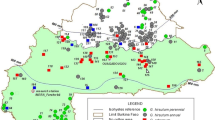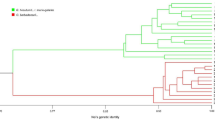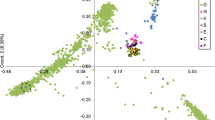Abstract
Amplified fragment length polymorphism fingerprinting was applied to survey the genetic diversity of primitive South American Gossypium barbadense cotton for establishing a possible link to its pre-Columbian expansion. New germplasm was collected along coastal Peru and over an Andean transect in areas where most of the archaeological evidence relating to cotton domestication has been recorded. Gene bank material of three diploid (G. raimondii, G. arboreum, and G. herbaceum) and four allotetraploid cotton species (G. hirsutum, G. mustelinum, G. tomentosum and additional G. barbadense) was added for inter- and intra-specific comparison. Eight primer combinations yielded 340 polymorphic bands among the 131 accessions. The obtained neighbor joining and unweighted pair-group method with arithmetic means are in full agreement with the known cytogenetics of the tetraploid cottons and their diploid genome donors. The four tetraploid species are clearly distinct based on taxonomic classification. The genetic diversity within G. barbadense reveals geographic patterns. The locally maintained cottons from coastal Peru display a distinct genetic diversity that mirrors their primitive agro-morphological traits. Accessions from the northernmost coast of Peru and from southwestern (SW) Ecuador cluster basal to the east-of-Andes accessions. The remaining accessions from Bolivia, Brazil, Columbia, Venezuela, and the Caribbean and Pacific islands cluster with the east-of-Andes accessions. Northwestern Peru/SW Ecuador (the area flanking the Guayaquil gulf) appears to be the center of the primitive domesticated G. barbadense cotton from where it spread over the Andes and expanded into its pre-Columbian range.


Similar content being viewed by others
References
Abdalla AM, Reddy OUK, El-Zik KM, Pepper AE (2001) Genetic diversity and relationships of diploid and tetraploid cottons revealed using AFLP. Theor Appl Genet 102:222–229
Brubaker CL, Wendel JF (1994) Reevaluating the origin of domesticated cotton (Gossypium hirsutum Malvaceae) using nuclear restriction fragment length polymorphisms (RFLP). Am J Bot 81:1309–1326
Brubaker CL, Bourland FM, Wendel JF (1999) The origin and domestication of cotton. In: Smith CW, Cothren JT (eds) Cotton: origin history, technology, and production, 1st edn. Wiley, New York, pp 3–31
Cronn RC, Zhao XP, Paterson AH, Wendel JF (1996) Polymorphism and concerted evolution in a tandemly repeated gene family: 5S ribosomal DNA in diploid and allopolyploid cottons. J Mol Evol 42:685–705
Cronn RC, Small RL, Wendel JF (1999) Duplicated genes evolve independently after polyploid formation in cotton. Proc Natl Acad Sci USA 96:14406–14411
Cronn RC, Small RL, Haselkorn T, Wendel JF (2002) Rapid diversification of the cotton genus (Gossypium: Malvaceae) revealed by analysis of sixteen nuclear and chloroplast genes. Am J Bot 89:707–725
Dejoode DR, Wendel JF (1992) Genetic diversity and origin of the Hawaiian-Islands cotton, Gossypium tomentosum. Am J Bot 79:1311–1319
Dice LR (1945) Measures of the amount of ecologic association between species. Ecology 26:297–308
Drossou A, Katsiotis A, Leggett JM, Loukas M, Tsakas S (2004) Genome and species relationships in genus Avena based on RAPD and AFLP molecular markers. Theor Appl Genet 109:48–54
El-Rabey HA, Badr A, Schafer-Pregl R, Martin W, Salamini F (2002) Speciation and species separation in Hordeum L. (Poaceae) resolved by discontinuous molecular markers. Plant Biol 4:567–575
Endrizzi JE, Turcotte EL, Kohel RJ (1985) Genetics, cytology, and evolution of Gossypium. Adv Genet 23:271–375
Felsenstein J (1985) Confidence limits on phylogenies: an approach using the bootstrap. Evolution 39:783–791
Fernandez HAM, Rodriguez REF, Westengen O (2003) Biología y Etnobotánica del Algodón Nativo Peruano (Gossypium barbadense L., Malvaceae). Arnaldoa 10:93–108
Fryxell PA (1992) A revised taxonomic interpretation of Gossypium L., (Malvacea). Rheedea 2:108–165
Heun M, SchaferPregl R, Klawan D, Castagna R, Accerbi M, Borghi B, Salamini F (1997) Site of einkorn wheat domestication identified by DNA fingerprinting. Science 278:1312–1314
Hutchinson JB, Silow RA, Stephens SG (1947) The evolution of Gossypium and the differentiation of the cultivated cottons, 1st edn. Oxford University Press, London
Kardolus JP, van Eck HJ, van den Berg RG (1998) The potential of AFLPs in biosystematics: a first application in Solanum taxonomy (Solanaceae). Plant Syst Evol 210:87–103
Lacape JM, Nguyen TB, Thibivilliers S, Bojinov B, Courtois B, Cantrell RG, Burr B, Hau B (2003) A combined RFLP-SSR-AFLP map of tetraploid cotton based on a Gossypium hirsutum×Gossypium barbadense backcross population. Genome 46:612–626
Liu Q, Brubaker CL, Green AG, Marshall DR, Sharp PJ, Singh SP (2001) Evolution of the FAD2-1 fatty acid desaturase 5′ UTR intron and the molecular systematics of Gossypium (Malvaceae). Am J Bot 88:92–102
First evidence of cotton at Neolithic Mehrgarh, Pakistan: analysis of mineralized fibres from a copper bead. J Archaeol Sci 29:1393–1401
Nei M, Li WH (1979) Mathematical model for studying genetic variation in terms of restriction endonucleases. Proc Natl Acad Sci USA 76:5269–5273
Percival AE, Kohel RJ (1990) Distribution, collection, and evaluation of Gossypium. Adv Agron 44:225–256
Percy RG, Wendel JF (1990) Allozyme evidence for the origin and diversification of Gossypium barbadense L. Theor Appl Genet 79:529–542
Phillips LL (1963) The cytogenetics of Gossypium and the origin of New World cottons. Evolution 17:460–469
Phillips LL (1964) Segregation in new allopolyploids of Gossypium. V. Multivalent formation in New World × Asiatic and New World × wild American Hexaploid. Am J Bot 51:324–329
Piperno DR, Pearsall DM (1998) The origins of agriculture in the lowland Neotropics. Academic, San Diego
Rohlf FJ (2000) Numerical taxonomy and multivariate analysis system, ver. 2.11. Applied Biostatistics, New York
Rossen J, Dillehay TD, Ugent D (1996) Ancient cultigens or modern intrusions? Evaluating plant remains in an Andean case study. J Archaeol Sci 23:391–407
Saitou N, Nei M (1987) The neighbour-joining method: a new method for reconstructing phylogenetic trees. Mol Biol Evol 4:406–425
Sasanuma T, Chabane K, Endo TR, Valkoun J (2004) Characterization of genetic variation in and phylogenetic relationships among diploid Aegilops species by AFLP: incongruity of chloroplast and nuclear data. Theor Appl Genet 108:612–618
Schwendiman J, Ano G, Percival AE (1986) Cotton collecting in continental Ecuador and Galapagos Islands. FAO/IPBGR Plant Genet Resources Newsl 64:33–37
Seelanan T, Schnabel A, Wendel JF (1997) Congruence and consensus in the cotton tribe (Malvaceae). Syst Bot 22:259–290
Seelanan T, Brubaker CL, Stewart JM, Craven LA, Wendel JF (1999) Molecular systematics of Australian Gossypium section Grandicalyx (Malvaceae). Syst Bot 24:183–208
Senchina DS, Alvarez I, Cronn RC, Liu B, Rong JK, Noyes RD, Paterson AH, Wing RA, Wilkins TA, Wendel JF (2003) Rate variation among nuclear genes and the age of polyploidy in Gossypium. Mol Biol Evol 20:633–643
Small RL, Wendel JF (2000) Phylogeny, duplication, and intraspecific variation of Adh sequences in new world diploid cottons (Gossypium L., Malvaceae). Mol Phylogenet Evol 16:73–84
Small RL, Ryburn JA, Cronn RC, Seelanan T, Wendel JF (1998) The tortoise and the hare: choosing between noncoding plastome and nuclear ADH sequences for phylogeny reconstruction in a recently diverged plant group. Am J Bot 85:1301–1315
Small RL, Ryburn JA, Wendel JF (1999) Low levels of nucleotide diversity at homoeologous Adh loci in allotetraploid cotton (Gossypium L.). Mol Biol Evol 16:491–501
Sokal RR, Sneath PHA (1963) Principles of numerical taxonomy. Freeman, San Francisco
Solis RS, Haas J, Creamer W (2001) Dating caral, a preceramic site in the Supe Valley on the central coast of Peru. Science 292:723–726
Stephens SG (1944) Phenogenetic evidence for the amphidiploid origin of New World cottons. Nature 153:53–54
Stephens SG (1975) A reexamination of the cotton remains from Huaca Prieta, North Coastal Peru. Am Antiquity 40:406–419
Stephens SG, Moseley EM (1973) Cotton Remains from archeological sites in central coastal Peru. Science 180:186–188
Stephens SG, Moseley ME (1974) Early domesticated cottons from archaeological sites in central coastal Peru. Am Antiquity 39:109–122
Sudupak MA, Akkaya MS, Kence A (2004) Genetic relationships among perennial and annual Cicer species growing in Turkey assessed by AFLP fingerprinting. Theor Appl Genet 108:937–944
Swofford DL (1998) paup*: phylogenetic analysis using parsimony (*and other methods) ver. 4.0b10 for Macintosh. Sinauer, Sunderland
Turcotte EL, Percy RG (1990) Genetics of kidney seed in Gossypium barbadense L. Crop Sci 30:384–386
Ude G, Pillay M, Nwakanma D, Tenkouano A (2002) Analysis of genetic diversity and sectional relationships in Musa using AFLP markers. Theor Appl Genet 104:1239–1245
Vos P, Hogers R, Bleeker M, Reijans M, Vandelee T, Hornes M, Frijters A, Pot J, Peleman J, Kuiper M, Zabeau M (1995) AFLP—a new technique for DNA-fingerprinting. Nucleic Acids Res 23:4407–4414
Vreeland JM (1999) The revival of colored cotton. Sci Am 280:112–118
Wendel JF (1989) New world tetraploid cottons contain Old-World cytoplasm. Proc Natl Acad Sci USA 86:4132–4136
Wendel JF (1995) Cotton. In: Simmonds S, Smartt J (eds) Evolution of crop plants, 1st edn. Longman, London, pp 358–366
Wendel JF, Albert VA (1992) Phylogenetics of the cotton genus (Gossypium)—character-state weighted Parsimony analysis of chloroplast-DNA restriction site data and its systematic and biogeographic implications. Syst Bot 17:115–143
Wendel JF, Cronn RC (2003) Polyploidy and the evolutionary history of cotton. Adv Agron 78:139–186
Wendel JF, Percy RG (1990) Allozyme diversity and introgression in the Galapagos-Islands endemic Gossypium darwinii and its relationship to continental Gossypium barbadense. Biochem Syst Ecol 18:517–528
Wendel JF, Rowley R, Stewart JM (1994) Genetic diversity in and phylogenetic-relationships of the Brazilian endemic cotton, Gossypium mustelinum (Malvaceae). Plant Syst Evol 192:49–59
Acknowledgements
We thank Dr. E. Percival (USDA-ARS, Texas) for providing seed material. We also extend our gratitude to J. Lazo, G. Arevalo, F. Balavarca, and C. Basurto for assistance and information; K. Ramirez and M.R. Pastor at INRENA for obtaining the permission to collect and export the germplasm; M. White, C. Deza, E. Rodriguez, and V. Medina for accompanying the collecting efforts in La Libertad; M.I. Olivos Farro and J. Escurra Puicon for collaboration in Lambayeque; P.M. Reyes More for information; E. Manco for access to PRONIRGEB germplasm; P. Azang Huaman for collaboration in San Martin (all in Peru). Thanks are also due to K. Vollan and J.H. Sønstebø for their advice and technical assistance during laboratory work at AUN, Norway.
Author information
Authors and Affiliations
Corresponding author
Additional information
Communicated by H.C. Becker
This publication is dedicated to Prof. Dr. Drs.h.c. Gerhard Röbbelen on the occasion of his 75th birthday
Rights and permissions
About this article
Cite this article
Westengen, O.T., Huamán, Z. & Heun, M. Genetic diversity and geographic pattern in early South American cotton domestication. Theor Appl Genet 110, 392–402 (2005). https://doi.org/10.1007/s00122-004-1850-2
Received:
Accepted:
Published:
Issue Date:
DOI: https://doi.org/10.1007/s00122-004-1850-2




